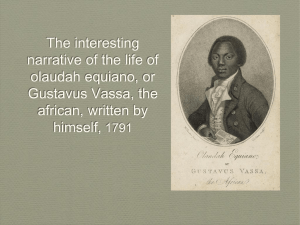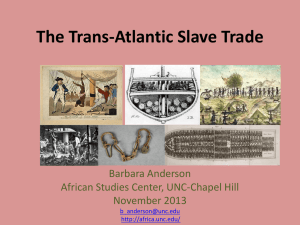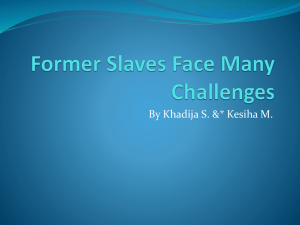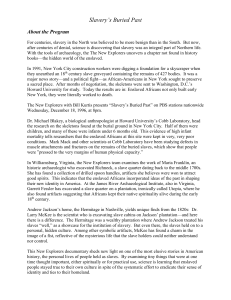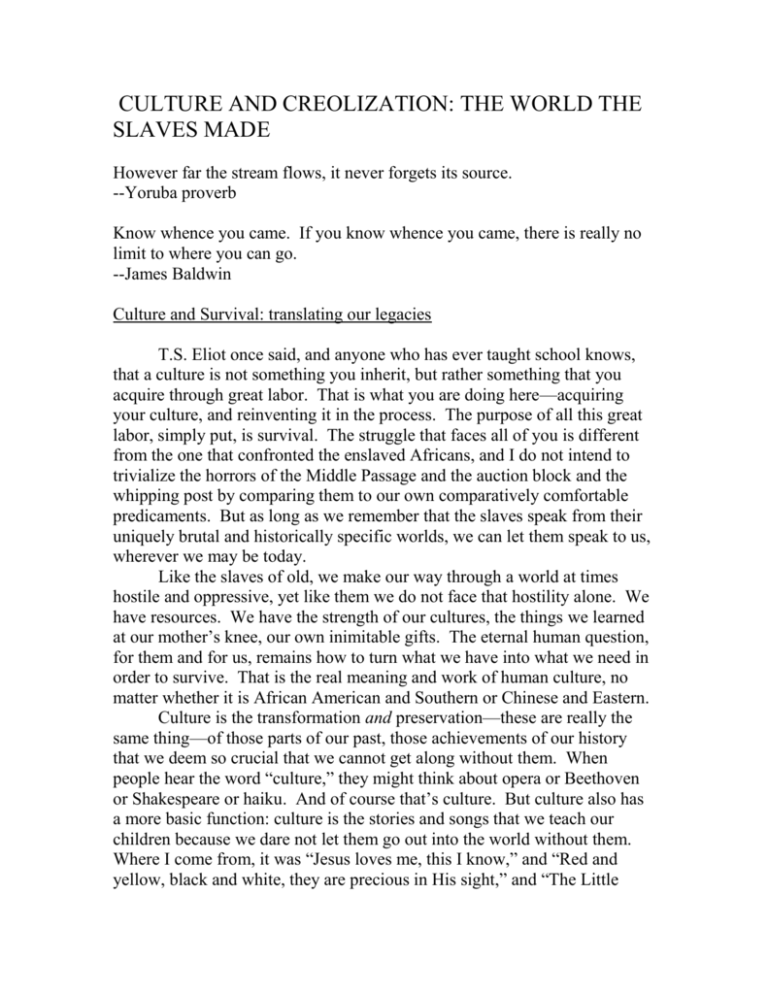
CULTURE AND CREOLIZATION: THE WORLD THE
SLAVES MADE
However far the stream flows, it never forgets its source.
--Yoruba proverb
Know whence you came. If you know whence you came, there is really no
limit to where you can go.
--James Baldwin
Culture and Survival: translating our legacies
T.S. Eliot once said, and anyone who has ever taught school knows,
that a culture is not something you inherit, but rather something that you
acquire through great labor. That is what you are doing here—acquiring
your culture, and reinventing it in the process. The purpose of all this great
labor, simply put, is survival. The struggle that faces all of you is different
from the one that confronted the enslaved Africans, and I do not intend to
trivialize the horrors of the Middle Passage and the auction block and the
whipping post by comparing them to our own comparatively comfortable
predicaments. But as long as we remember that the slaves speak from their
uniquely brutal and historically specific worlds, we can let them speak to us,
wherever we may be today.
Like the slaves of old, we make our way through a world at times
hostile and oppressive, yet like them we do not face that hostility alone. We
have resources. We have the strength of our cultures, the things we learned
at our mother’s knee, our own inimitable gifts. The eternal human question,
for them and for us, remains how to turn what we have into what we need in
order to survive. That is the real meaning and work of human culture, no
matter whether it is African American and Southern or Chinese and Eastern.
Culture is the transformation and preservation—these are really the
same thing—of those parts of our past, those achievements of our history
that we deem so crucial that we cannot get along without them. When
people hear the word “culture,” they might think about opera or Beethoven
or Shakespeare or haiku. And of course that’s culture. But culture also has
a more basic function: culture is the stories and songs that we teach our
children because we dare not let them go out into the world without them.
Where I come from, it was “Jesus loves me, this I know,” and “Red and
yellow, black and white, they are precious in His sight,” and “The Little
Engine That Could”—“I think I can, I think I can.” Mama and Grandmother
before her did not want us wandering around the world not knowing who we
were and whose we were. They wanted us to know that God loved us, but
no more than anyone else. They insisted that we think we could, think we
could, think we could. All of you no doubt grew up on stories and songs of
your own cultures.
Culture is the way that we turn what we have into what we need, the
way that we transform the past into the future. That is what many of you are
doing here; trying to turn your past into your future. Trying to turn the
things you brought with you—your talents, your tenacity, your beauty, your
love, your sense of humor, your stories, and perhaps most importantly your
heritage—into a life for yourself and your children.
We know that strength comes from our roots, and so we cling to our
heritages. But life will not permit us to turn our past into a shrine. It won’t
work; our past is either a living fountain or simply a dead weight. And
turning that weight into wings—that is the work of culture.
Here we find ourselves, confronting our own New Worlds, wedged in
a system not of our own making, not designed for our benefit, often
indifferent to our individuality and at times contemptuous of our highest
capacities. And we are armed only with the legacies of a distant shore. But
in these legacies are the seeds of our survival.
Being a cook and altogether too literal-minded, I picture these seeds
literally—dried seeds and musty tubers in an earthenware jar, stowed in the
bottom of a slave ship—rice, okra, yams, peanuts, field peas, eggplant. All
of these seeds, like the slaves, were stolen away from the shores of Africa.
And yet these seeds, like the ones you have with you, must be sorted
and culled, the withered and useless ones thrown away, the good ones
watered with the fresh streams of this far country where we have landed.
We need what we brought with us, but there may be something here we can
use, too. This was the challenge that the slaves stolen from Africa, surviving
the horrors of the Middle Passage and the auction block, faced with such
enormous creativity and discipline. How to translate their rich and diverse
legacies and adapt them to a New World. How Yoruba and Ibo and Wolof
became one people—African Americans. That dynamic process of
preservation, translation, and renewal we are going to call creolization. And
so we proceed to examine a few of the ways in which this enormous cultural
achievement manifested itself.
A Metaphor for Creolization: the model of language along the South
Carolina Coast
Africans spoke hundreds of different languages. They could not
understand each other automatically in the hold of that slave ship, though
they understood that they were in the same boat. That was where black
nationalism was born, in the embattled solidarity among shipmates. The
Africans even developed a word for the special relationship among those
who had made the Middle Passage together: melunga. In this class, in a
certain sense, we will be melungas—we are making this voyage together,
though I do not mean to literally compare our predicaments to those of the
enslaved Africans. And yet we are making this voyage together, and we are
trying to find a language to understand one another, are we not?
The language that the newly-arrived slaves created among themselves
in this part of the world was a pidgin form of English: a tongue developed as
a means of communication among speakers of different languages; by
definition, it has no native speakers. Wait people at restaurants develop a
pidgin: “two dogs dressed and walking,” someone might say, rather than
“two hotdogs, chili, mustard, slaw and onions, to go.” It is a functional
communication but it does not do everything that a language needs to do,
necessarily. And it has no native speakers.
When children are born to a people who speak a pidgin, the pidgin
becomes those children’s native language. Linguists call a pidgin that
acquires native speakers a “creole.” That is, unlike a pidgin, a creole serves
all of the functions of a language.
Along the South Carolina coast, on the Sea Islands, the resulting
creole language was Gullah. It continued to develop, taking on mostly
English vocabulary while retaining a largely African grammar; that is, the
deep structure of Gullah was mostly African, while most of the individual
words were English. And thus black culture in the South was never fully
separate from white Southern culture, and yet it was always separate, too, in
another sense.
This process of creolization did not limit itself to language but was
about the whole creation of the most powerful expressive culture in the
history of the world. Creolization established “Africanity,” in a sense; the
pressures of slavery in the New World clarified underlying commonalities
among the many African nationalities, and then created African American
culture. And it was never entirely separate and never even close to fully
assimilated, either. Even when it seemed consonant with white European
culture, its purposes were always different, because the culture of the black
South was inherently an oppositional culture—oppositional to the idea that a
person can be a thing.
The creation this creole language in coastal South Carolina was an
important cultural event in itself, but the important thing that I am trying to
communicate here is that the creolization of language is a great metaphor for
the creation of African American culture as a whole. Now let us look at
religion, which we let us look at music, which may help explain why “The
South in Black and White” spends so much energy on music. It isn’t just
about Mrs. Williams’s beautiful voice, though we appreciate it, but it is
about something as rich and subtle as Dante or Shakespeare, something that
speaks to the ages in a profound voice and deserves our serious attention.
Religion and creolization
The African American conversion to to Christianity was probably the
most decisive and important step in the development of African American
culture—maybe in the creation of American culture, for that matter, since
culture will not stay in a box, and this theology of liberation that developed
in the black South, in opposition to slavery, was our first abolitionism, in the
beginning, and in the end was the only thing that granted the Declaration of
Independence and the U.S. Constitution their full meaning for the world.
When we say “conversion,” it is important to remember that African
Americans did not so much convert to Christianity as convert Christianity;
they don’t so much adopt Christianity as adapt Christianity, adapting this
faith to both their own enduring religious traditions and sensibilities and to
the oppressive new realities of their lives. We could even say that the
distinctive Afro-Christianity that is born in the antebellum South is itself a
kind of creole religion.
This creolization of religious expression brought about a dramatic
cultural transformation, from a wide range of African beliefs and practices to
a distinctive Afro-Christianity that reflected both this newly acquired faith
and inherited African religious traditions. And it went on to transform the
culture of the South and the nation, though it turned out to be a three or fourhundred-year project, depending on when you start counting.
Masters of the enslaved encouraged the conversion of their alleged
property for a wide range of reasons, which no doubt sometimes included
genuine concern for the spiritual well-being of the Africans. We cannot
dismiss the religion of the masters just because they were hypocrites like us;
indeed, many of them were probably fervently devout Christians who simply
could not see themselves. And certainly they could not always see the
philosophical perils of their position, because Christianity—as the enslaved
Africans saw instantly--also had the potential to call masters to account. If
the masters were as responsible to the demands of the Christian faith as their
slaves were, that could present a challenge to the designated roles and racial
boundaries on the plantation. And so the masters carefully taught the slaves
highly selective version of Christianity, which stressed obedience and longsuffering. They were aware that religion had the capacity to be a more
subtle and perhaps even more effective means of control than the whip.
In the library you could find a book, for example, by Reverend
Alexander Glennie of Allsaints’ Parish on the coast of South Carolina in the
1840s, and it begins with a long quote from the Bible. The book is intended
to instruct white preachers who might address slave congregations—“talking
points,” we might call them today—draft sermons. Here’s what Rev
Glennie recommended:
“`Servants, be obedient to them that are your masters according to the
flesh, with fear and trembling, in singleness of your heart, as unto
Christ; not with eye service as men pleasers; but as the servants of
Christ, doing the will of God from the heart: with good will doing
service, as to the Lord and not to men; knowing that whatsoever good
thing any man doeth, the same shall he receive of the Lord, whether
he be bond or free.’ This passage from the Bible shews to you, what
God requires from you as servants; and there are many other passages
which teach the same things. You should try and remember these
parts of the Bible, that you may be able `to do your duty in that state
of life unto which it has pleased God to call you.’ For although a bad
servant may not wish to know what God requires of him, yet a
Christian servant will desire to know this, and to do His will in every
thing.”
One slave complained: “Church was what they called it, but all that preacher
talked bout was for us slaves to obey our masters and not to lie and steal.
Nothing about Jesus was ever said and the overseer stood there to see the
preacher talked the way he wanted him to talk.”
The dilemma that faced the slaveholders was that, despite a light
sprinkling of Bible verses that could be interpreted as acceptances of
slavery, Christianity and the Bible were inherently subversive of slavery.
For example, the poor slaveholders were certainly were in no position, bless
their little hearts, to preach to their slaves that Pharoah had enslaved the
children of Israel and held them in bondage in Egypt, but that the Lord had
visited a series of plagues on the slaveholders, and that Moses had parted the
waters of the sea and led a mass escape from slavery.
There was also a problem in the general egalitarianism that adheres in
the Christian faith: God is no respecter of persons, so the Bible says, but
instead all human beings are equal before Him. The Pharisees don’t come
off so well. Jesus had a very problematic habit of associating with the lowly
and snubbing the powerful. It was awkward.
The central dilemma was that Christianity—any religion, for that
matter, that might have been shared by slaves and masters—set up an
otherworldly system of values, standards external to the plantation, grounds
upon which the slaves might actually judge their masters, and find them
wanting. Listen to the lyrics here of “I Got Shoes,” and imagine the
enslaved Africans, standing barefoot in church and performing these lines
for their legal owners: “Everybody talking `bout heaven ain’t going there.”
Don’t think the slaveholders had no idea about the contradictions.
During the 1834 legislative debate in South Carolina, which passed laws
prohibited teaching slaves to read or write, one planter noted that anyone
who wanted slaves to read the ENTIRE Bible belonged “in a room at the
Lunatic Asylum.” And he had a very good point.
Like the metaphor of language, in which Gullah had English
vocabulary but African grammar, the distinctive Afro-Christianity that
emerged in the slave quarter had a vocabulary that was largely European but
a “grammar”—that is, the deep structure of slave religion—was African.
Out of the ongoing cultural creolization came a unique Afro-Christianity that
became the beating heart of African American culture. This faith focused
not on God the Cosmic Overseer, not so much the judge of human behavior,
but a god more like African deities: God the transcendent spirit. Theirs was
a distinct Afro-Christianity that concerned itself with freedom in this world,
not just salvation in the next world, and which was filled with what Cornel
West calls “subversive joy.”
Creolization and the Spirituals
The spirituals created by the slaves furnished a virtual theology in
song, and are the central texts of slave Christianity. They are complex, and
provide many different kinds of solace, inspiration, instruction and
belonging. Their themes and lyrics are generally from the Bible that the
Europeans gave them, but their style of singing was African: poly-rhythms;
syncopation; notes slide from one to the other rather than distinct and
separate notes; hand-clapping and foot-stomping and body movements of
African origins. And then there is the creolized heart of the spirituals, which
is their many-sided visions of liberation.
The music displayed a flexible, improvisational style with both
individual and communal structure: one person sings verses while “the
community” repeats a chorus known to all in “call and response” style. The
original expression is a “call,” the response both answers that call and in the
same moment creates another call, and then the original caller responds to
that one in a democratic and improvisational music that creates a
community.
Often the music had veiled meanings and even community
announcements: “Meeting at the Building” was a notification that church
would be held in the barn or in the woods or in the slave quarter. “Wade in
the Water,” “Steal Away,” and “Run, Mary, Run” are practically instructions
for running away.
Other songs unfurl visions of liberation: “Go Down, Moses,” “I’ll Fly
Away,” and “Shadrach,” which Mrs. Williams will share with us soon, are
all visions of liberation from slavery, as well as from the troubles of this
world. Listen to “Go Down, Moses,” please: “Go down, Moses, way down
in Egypt land/ Tell old Pharaoh, ‘Let my people go.’” You don’t have to be
much of a literary critic to catch that one. “I’ve Got a Right to the Tree of
Life” is a declaration of universal human equality, as is “Didn’t My Lord
Deliver Daniel”—and, as the nameless author of the spiritual demands to
know, “and why not every man?”
Some of these visions of liberation are downright apocalpyptic. We
will ask Mrs. Williams to sing “Looking for the Stone.” Here is a snatch of
the words: “I’m looking for the stone that was hewn out of the mountain,
Lord, I’m looking for the stone to come rolling down through Babylon / I’m
looking for the stone that was hewn out of the mountain, Lord, tearing down
the kingdom of this world.” And we’ll hear “Sampson and Delilah”
declaration that “If I had my way, I would tear this whole building down.”
Maybe I would have been a paranoid slaveholder, but I am not sure those
folks are singing purely and only about the Bible. And in “Mary Don’t You
Weep,” why are they so happy that “Pharoah’s army got drowned,” may I
ask?
Other songs are more about solace and comfort and emotional release.
“Soon I Will Be Done,” for example, or “Sometimes I Feel Like a
Motherless Child.” The God of the oppressed was comforting, soothing,
inspiring, and revolutionary by turns, promising comfort in this world and
freedom in the next—or even in this world. When Dr. King said at the
March on Washington in 1963, “Out of the mountain of depair, we will
hewn a stone of hope,” he was looking for the stone that would tear down
the kingdom of this world. This was a culture with a revolutionary project.
Birth of the Black Church: “The Invisible Institution
Masters and slaves often worshipped together, but some blacks had
separate churches even before Emancipation, when virtually all black
Southerners fled into their own institutions. In racially-mixed churches
during slavery, the enslaved often outnumbered whites and Southern religion
generally underwent enormous African American influence that can still be
seen, heard and felt today.
But black religious life extended far beyond the walls of the formal
church: “the invisible institution” huddled in woods and barns and secret
places, in the “brush arbor,” as the enslaved call it, where they could express
themselves freely. The masters knew these gatherings were a threat and
often forbade them. Slaves faced severe punishment for attending secret
religious gatherings, but did so just the same.
In his Critique of Hegel’s Philosophy of Right, Karl Marx dismisses
Christianity as “the opiate of the people,” and perhaps there is truth to that
assessment in some instances. It is worth noting that in the preceding
sentence, however, Marx calls religion “the heart of a heartless world.” That
seems closer to the mark. It is true, no doubt, that Christianity among the
enslaved brought comfort to the afflicted, and they tried to use it to afflict
the comfortable, too. It probably did undercut to some extent the spirit of
revolt, building communities that slaves hesitated to risk losing, salving
wounds that might have driven some to revolt. But to a much greater extent,
and especially over the long haul, this distinctive Afro-Christianity became a
revolutionary creed of self-affirmation and resistance.
The creolized faith of the enslaved said to them, like the unknown
poet of the spirituals, “I’ve Got a Right to the Tree of Life.” And in a world
that still seeks to make persons a means rather than an end, in a world that
persistently treats people as things, those words are still revolutionary.
Tim Tyson
Copyright February 2007. All rights reserved. Not for publication in any
form. The ideas here are not entirely my own, by any means. I would like
to note, in particular, the influence of James Cone, God of the Oppressed;
Albert Raboteau, Slave Religion; Charles Joyner, Down By the Riverside,
and my years of conversation with Craig Werner and my collaboration and
conversation with Mrs. Mary D. Williams.




